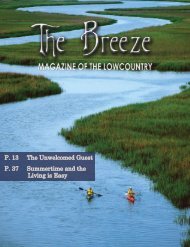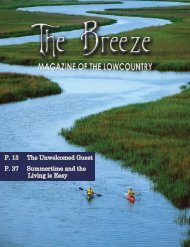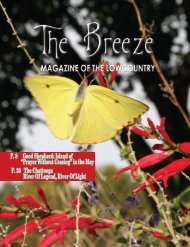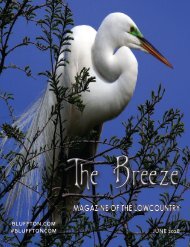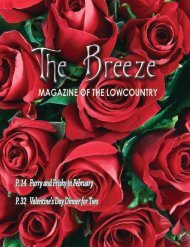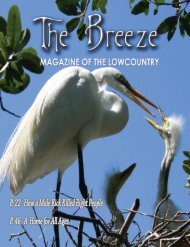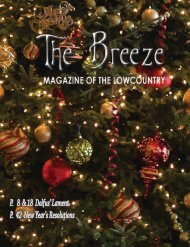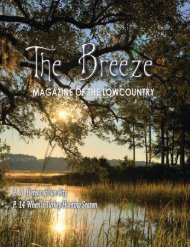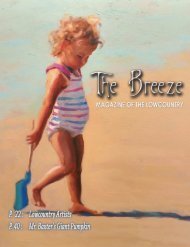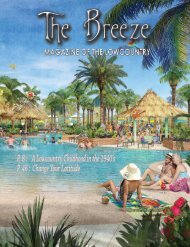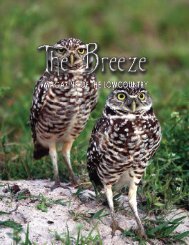Create successful ePaper yourself
Turn your PDF publications into a flip-book with our unique Google optimized e-Paper software.
Indians, were spared for some days, but while<br />
attempting to make their escape they were<br />
retaken and put to death.<br />
<strong>The</strong> land, laid in complete waste, cattle and<br />
crops destroyed from the Indian Wars, went to<br />
his son, James Cochran (Elder). James spent<br />
most of his life acquiring land and defending<br />
it from Indians. He purchased tracts and<br />
grants near Will Town, Jehoshua Island, a<br />
Combahee River Island, land on St. Helena<br />
Island, Daufuskie Island, Callawassie Island and<br />
in Colleton County. He received the rank of<br />
Major in service of the King and was elected a<br />
member of the Commons House of Assembly<br />
from Colleton County that met in Charles Town.<br />
He died between 1719 and 1724, when James<br />
Cochran (Younger) became heir to his father’s<br />
properties in over 20 tracts totally 10,918 acres.<br />
In 1738 James (Younger) had a house built on<br />
Cochran’s Island employing<br />
“tabby brick” and tabby<br />
“chinking mortar. James<br />
was known to either be<br />
consuming a gallon of rum<br />
failing to avoid the smallpox<br />
or treating his fellow<br />
Assemblymen liberally to this<br />
refreshment. Following his<br />
death in 1739/40 Cochrans’s<br />
Island became the property<br />
of Mary Cochran Ash, his<br />
only niece.<br />
Mary remains a mystery,<br />
almost a myth, as there is<br />
only a “Gift Deed of slaves<br />
from her father, Richard Ash<br />
that we know she was born<br />
before 1736 and was still living<br />
in 1752 It is known that Mary<br />
Cochran Ash’s daughter, Mary<br />
Ash, her successor, spent her<br />
childhood in Paul’s Parish,<br />
and after her marriage to George Barksdale<br />
they moved to her island. She died soon after<br />
giving childbirth. <strong>The</strong> Island’s ownership then<br />
followed to her son George Edwards born in<br />
1800. After George grew up the real property<br />
and a great fortune was made planting sea<br />
island cotton. It was during this time that the<br />
Tabby Mansion and outbuildings were built.<br />
By 1820 George owned 230 slaves; of these 130<br />
were engaged in agriculture, and as he cleared<br />
<strong>Breeze</strong> History<br />
additional land, it was said that George Edwards made<br />
around $100,000 a year on his cotton. Upon his death<br />
the title to Spring Island remained in litigation for many<br />
years, it eventually going to his son, George Barksdale<br />
Edwards. During this time due to the litigation expenses<br />
and upcoming war , the land and slaves acquired by his<br />
family over 154 years, was wiped out. In 1872 Spring<br />
Island was sold to Elizabeth Inwood for $8,600, for the<br />
Federal levied taxes at the court house steps, prices being<br />
so depressed following the Civil War. When Elizabeth<br />
died the land went to her only son Trenholm Inwood, who<br />
would become the last descendant of Indian trader, John<br />
Cochran, to own the island.<br />
<strong>The</strong> property changed hands a number of times between<br />
1895 and 1966 when Mr. & Mrs. Elisha Walker, Jr.<br />
purchased the land and once again Spring Island became<br />
the center of much activity. Walker is said to have spent<br />
upwards of a million dollars each year improving the<br />
island infrastructure. After their death in 1982 the Elisha<br />
Walker Trust and Gordon Mobley,<br />
Plantation Manager managed<br />
the Island. <strong>The</strong> island was made<br />
available for quail hunt- ing<br />
through the guest list that was<br />
“closely held”. Groups of four<br />
hunters would visit the Island for<br />
$10,000 a week for hunting quail,<br />
deer and occasionally ducks and<br />
turkey.<br />
In 1990, with the vision of<br />
Developers and Environmentalists<br />
Jim Chaffin, Jim Light, and Dr. Peter<br />
LaMottte, 36 founders formed<br />
the Spring Island Trust. With the<br />
purchase the trust was dedicated<br />
to the protection of the islands<br />
natural environment and cultural<br />
history. <strong>The</strong> overall density of<br />
the Island was down-zoned from<br />
5,500 units to 500 units to allow for<br />
the creation of over 1000 acres of<br />
nature preserve and open space.<br />
<strong>The</strong> bridge from Callawassie opened in 1991. Arnold<br />
Palmer played the first round of golf on <strong>The</strong> Old Tabby<br />
Links, which he designed with Ed Seay in 1992. Many<br />
more milestones lie ahead as Spring Island continues to<br />
grow and evolve as a residential community.<br />
It is interesting to conjecture what John Cochran, Indian<br />
Trader, would think of the Island, should he visit today.<br />
It is comforting to believe that he would find the same<br />
beauty, charm and abundance of flora and fauna that<br />
characterized his home more than 300 years ago.<br />
9




